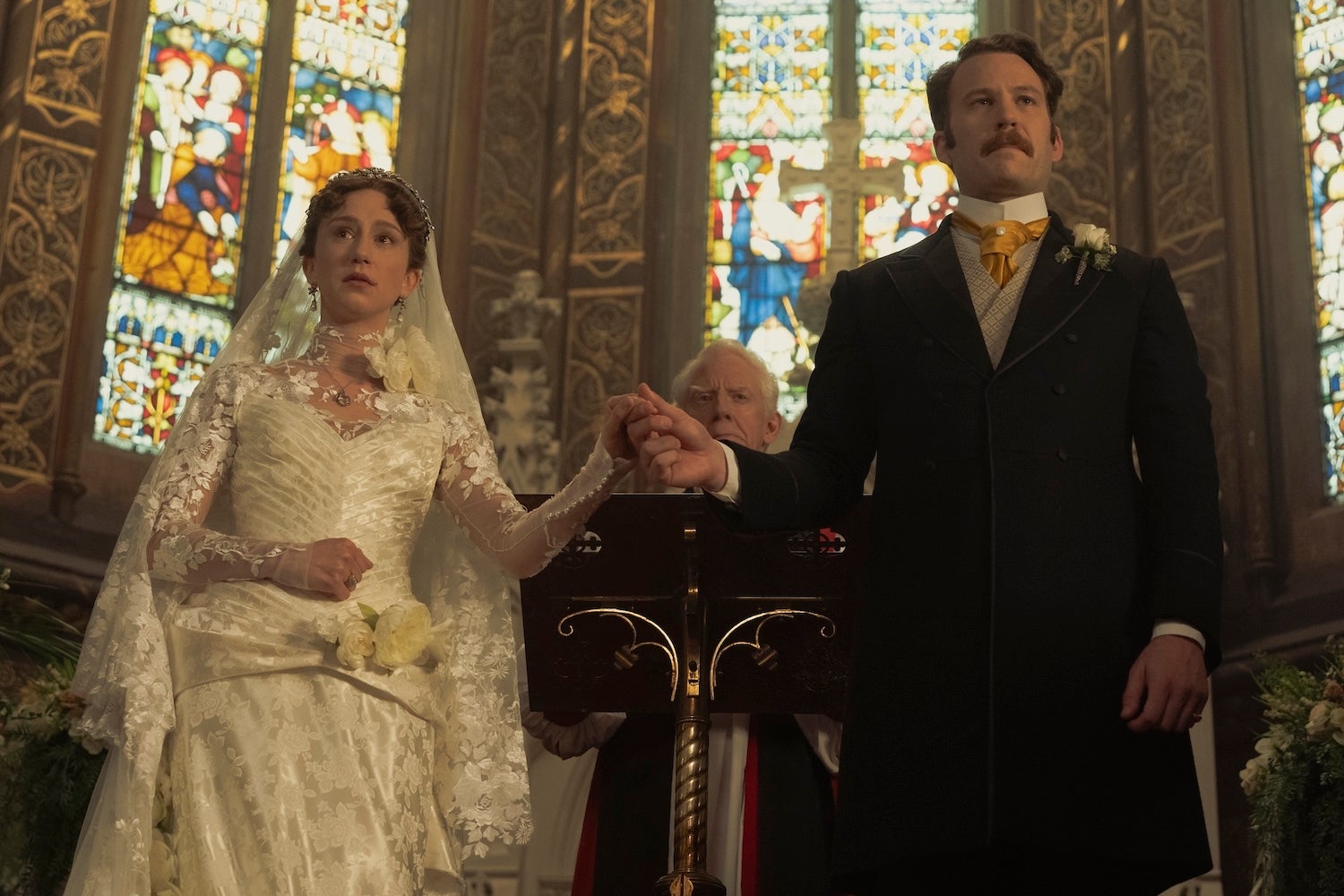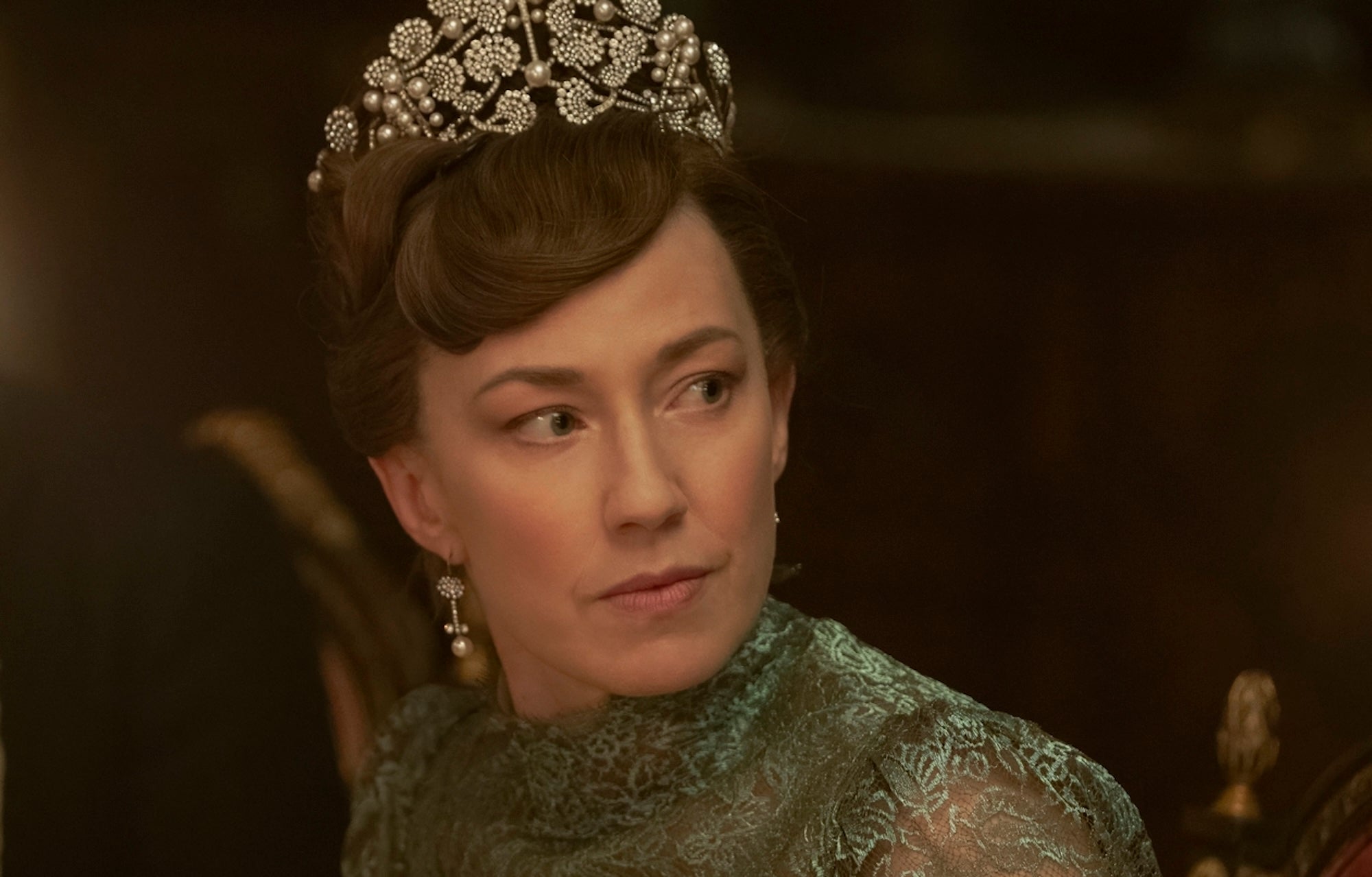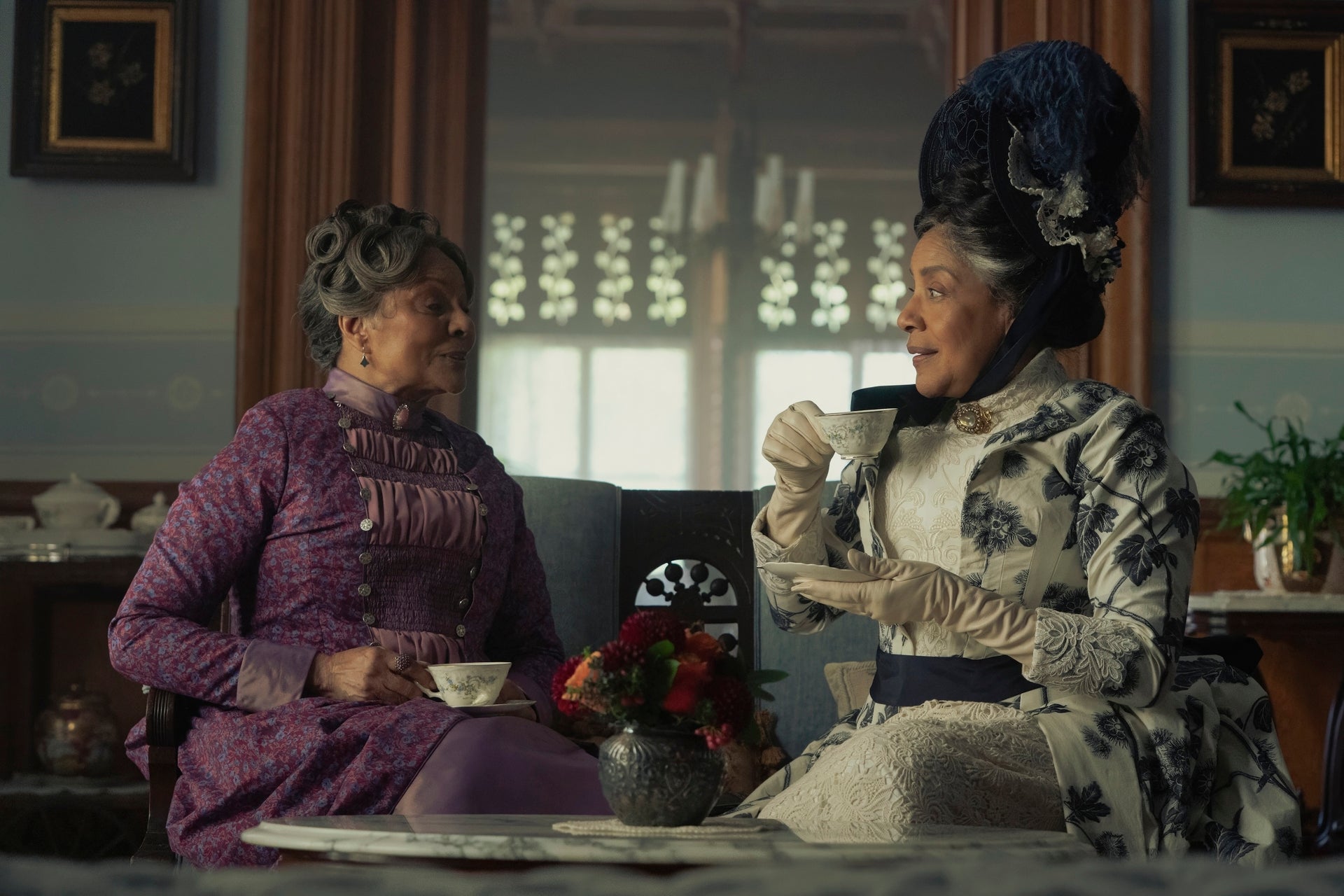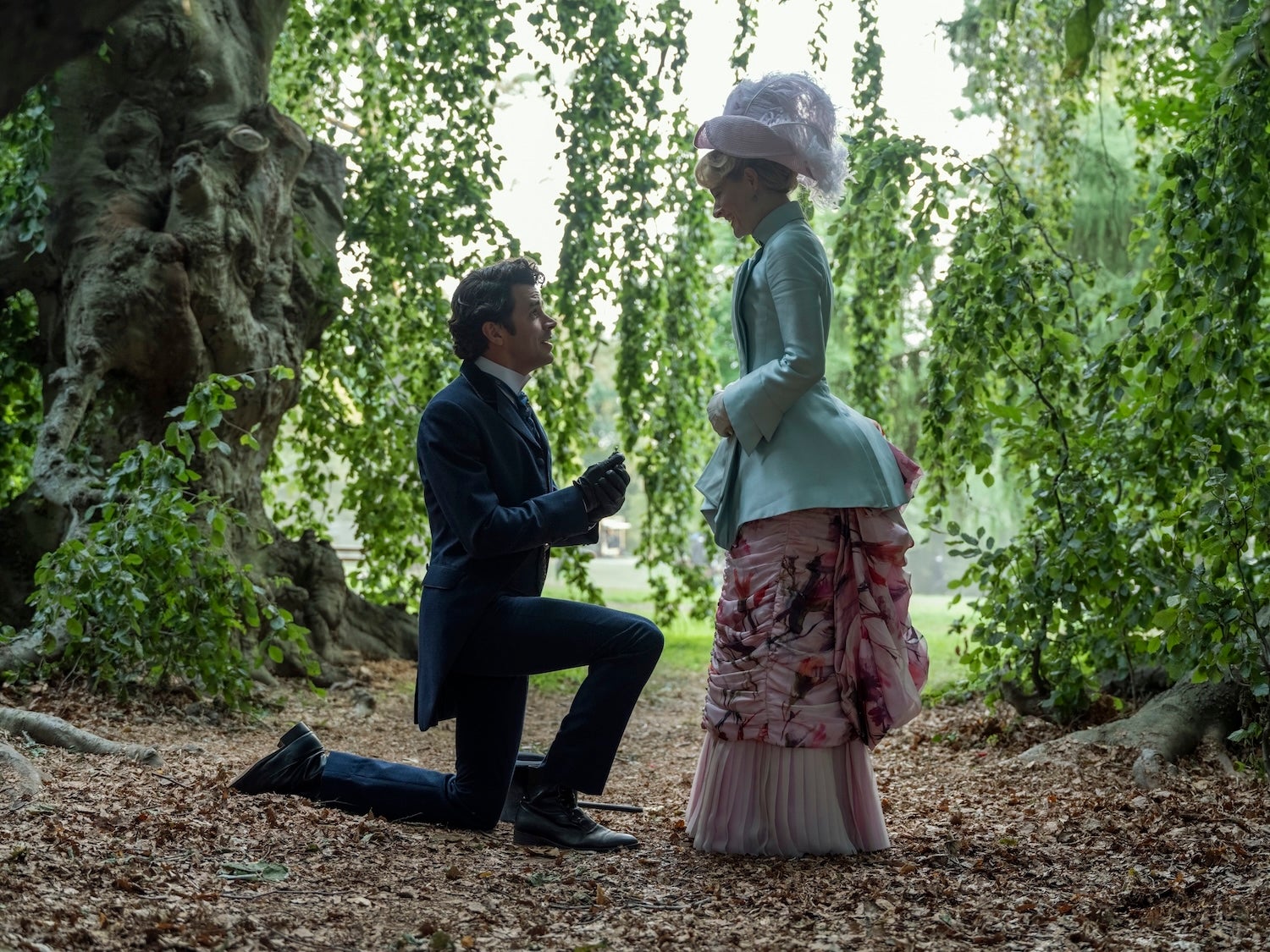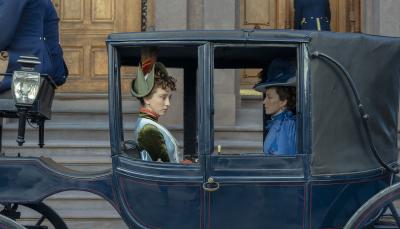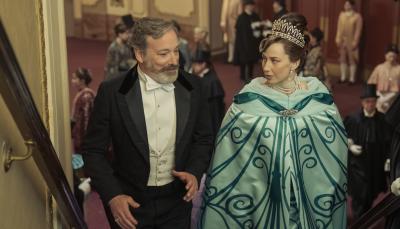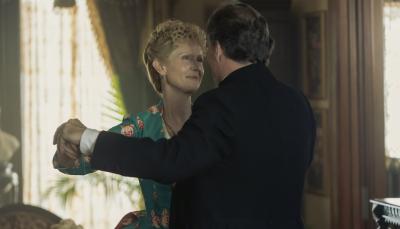Carrie Coon’s Costume Corner: 'The Gilded Age' Season 3 Runs the Gamut
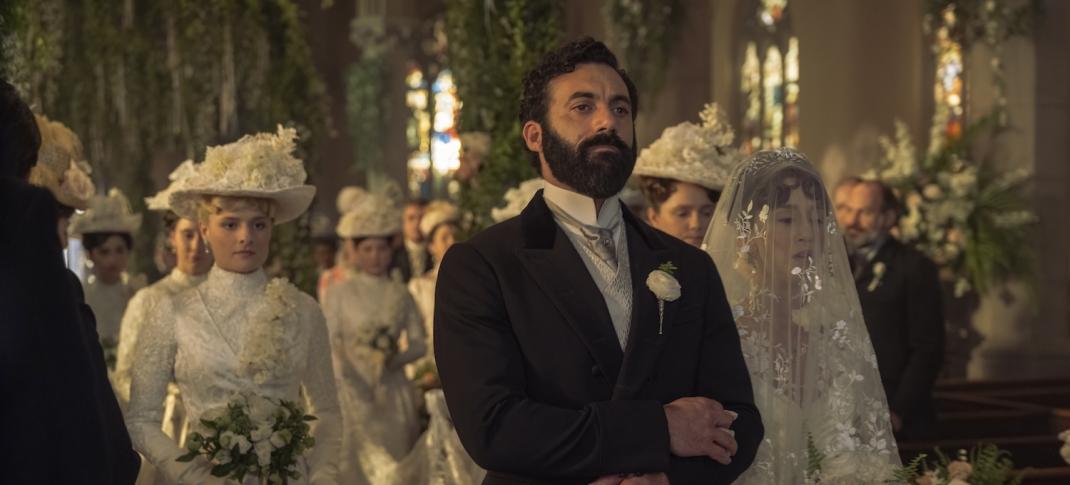
Morgan Spector and Taissa Farmiga in "The Gilded Age" Season 3
(Photo: Karolina Wojtasik/HBO)
Welcome back to Carrie Coon’s Costume Corner, where we take a costume design enthusiast’s look at the most exuberant, over-the-top, and memorable looks designed by Kasia Walicka Maimone and her team for the cast of The Gilded Age. If you’re new here, prior coverage of Season 3 is available here, and episode-by-episode Season 2 coverage starts here.
Since we’re covering several episodes at once in these Season 3 pieces, we’re focusing on bigger themes and story arcs. This highly eventful trio of episodes brings us Wedding Bell Blues; The Great Peggy Scott / Mrs. Kirkland War of 1884; and the opening skirmish between Team Buccaneers and Team Good Old Blighty (aka Bertha & Gladys vs. Lady Sarah).
Wedding Bell Blues
My goodness, we’re getting so much visual information in Episode 4, “Marriage Is A Gamble”. From the décor at Russell House to Gladys’s wedding gown, it’s a nonstop parade of character beats and cues. The moments I most want to highlight briefly before we get to The Gown pertain to the first-ever appearance of Bertha’s sister Monica (the always-welcome Merritt Weaver, who I hope we’ll see again). Bertha seemed content for Monica not to attend – indeed, it’s unclear if any other surviving members of either Bertha or George’s families of origin even exist – but when her sister turns up, she can’t very well turn her away. Monica is almost defiantly far more casual than Bertha, which bothers only Bertha. She goes a few steps farther with her needling, as only a sibling can do, by having brought exactly one dress for the festivities and scoffing at the suggestion that she might need more.
In Bertha’s defense, Monica’s gown is hideous and outdated, in mustard yellow and dark brown, with an exuberant bib constructed entirely of concentric Vs of lace. In Monica’s defense, why should she, a person who lives in Albany, with no interest at all in fitting in with Manhattan high society, give a hoot about how many gowns are considered average in her sister’s adopted social class. In Bertha’s defense, Monica’s lack of interest in fitting in only confirms Bertha’s habit of not including her sister in the first place. In theory, it’s nice that she offered to have some of her own gowns made over to fit Monica, but in fact, it’s a prime example of just how mean siblings can be to each other. Bertha is a wee slip of a thing and Monica has the voluptuous figure of a younger Mamie Fish; only the most extreme and resourceful letting out of seam allowances is going to make any of Bertha’s gowns come anywhere close to fitting her sister.
Gladys’s Wedding Gown
I was eagerly anticipating this look. I was ready to ooh and ahh admiringly, in great detail! It’s a huge bummer to have to report that the wedding gown of the year is a mess. It could have been bright optical white. It could have been ivory. It could have been cream. It is, unfortunately, all three.
The combined effect is visually incoherent and makes the sylph-like Gladys almost look like a child playing dress-up in the gown’s column silhouette. The veil and the train are lovely, and are shown off to particularly flattering advantage in the shots from above as Gladys and George make their desolate, grimly determined way down the aisle to Hector. This is the second major swing and miss in big moments for Gladys this season – Number One was her John Singer Sargent portrait that looked nothing at all like a John Singer Sargent portrait – I sincerely hope it will be the last.
Team Buccaneers and Team Good Old Blighty (a.k.a. Bertha & Gladys vs. Lady Sarah)
Next up, Bertha responds to Gladys’s SOS telegram about being miserably homesick and undermined by her imperious sister-in-law Lady Sarah by hopping on a steamship to assess the situation at Sidmouth for herself. Gladys’s ensembles in her new role as the Duchess of Buckingham are still very much what you’d expect for a very young person navigating previously unexplored terrain as an unenthusiastic newlywed suddenly shipped off to another country thousands of miles away from home. She has yet to develop a sophisticated, daring eye like her mother’s, which might be for the best at the moment.
Fortunately, her mother has fashion plate wattage to spare and shrewd advice for Gladys on asserting her authority as the ranking woman of Sidmouth Castle. I’m not sure what I appreciated more, the specific counsel to make herself knowledgeable about the estate and indispensable to Hector as his partner in managing the duchy and reviving its fortunes into the bargain. This is the kind of advice that Bertha should have been sharing with Gladys for at least the last five years. The plan was always to marry Gladys into a significant family, and regardless of the continent where she would make her new home, she’d need to hone precisely these skills.
The high point of Bertha’s wardrobe during her visit to Sidmouth Castle is the sober yet sparkly gown she wears for one of the Buckinghams’ formal dinners. The gown is paired with a tiara and a tall choker in the style that Queen Alexandra would make part of her signature look in the Edwardian era, emphasizing the queenliness that Bertha has invested so much time, money, taste, and shrewdness in cultivating.
We get only glimpses of Bertha’s gown while she’s seated at dinner and verbally jousting with Lady Sarah over the expansion of suffrage to all men and, dare we hope, to women, too. The sleeves are particularly memorable, as they’re made of a very delicate, sheer black fabric, dotted all over with tiny, faceted jewels (likely rhinestones) catching the light every time she moves. The effect calls to mind a starry night, another visual reminder of how regal and powerful Bertha is, vote or no.
Peggy vs. Mrs. Kirkland
The Gilded Age is finally starting to broaden the world of the show by making Peggy’s family and their social milieu among educated, upper-middle-class Black society. Meeting Dr. Kirkland and his parents, especially his formidable mother Elizabeth (played by Phylicia Rashad!!), provides opportunities to examine the specific social mores a woman like Peggy would face in that era as she navigates her personal and professional lives among wealthy white people. It’s interesting to see her ensembles in conversation with Elizabeth’s, particularly as they may be heading towards being family if Peggy and Dr. Kirkland marry. They’re constantly at loggerheads, with Peggy taking up progressive causes and Elizabeth being deeply invested in protecting the high social status she enjoys in Newport, and suspicious of any change that could take women out of the domestic sphere.
While both women often favor florals for their dresses, Elizabeth’s background colors are more restrained, and her silhouettes and accessories far more voluminous than Peggy’s. When Peggy appears in darker colors, the floral patterns balance them out by being quite lively. We don’t often see Peggy in a hat and gloves outside of quite formal settings, while one gets the idea that Elizabeth wouldn’t be caught dead without hers on almost any occasion.
Honorable Mention: Candy-Colored Young Ladies
For several episodes, Peggy (convalescing in Newport) and Marian (at home in Manhattan) are separated by a significant train ride, but geographical distance can’t prevent them from feeling a flirty, summery vibe in their dresses. Marian’s turquoise, pale pink and lilac ensemble during her walk with Larry and Peggy’s rainbow sherbet-inflected look at a baseball game with Dr. Kirkland both make the young ladies look like a multi-colored box of macarons. The youthful exuberance of their color palettes, is quite effective in reminding us that love is in bloom for both of them.


